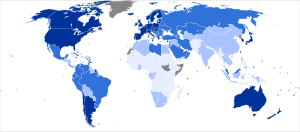Human Development Index facts for kids
The Human Development Index (HDI) is a special number that helps us understand how well people are living in different countries. It's like a report card for countries, showing how much progress they are making. This index is published by the United Nations Development Programme. It helps us compare countries and group them, for example, into "developed" (richer, more advanced) or "developing" (still growing) nations. The HDI score is a number between 0 and 1. A higher number means people generally have a better quality of life.
The Human Development Index looks at three main things to measure how people are doing:
- Long and Healthy Life: This is measured by how long people are expected to live at birth. It helps us see how healthy people are in a country. Generally, healthier people live longer.
- Knowledge and Education: This part looks at how educated people are. It checks how many adults can read and write. It also measures how many children of school age are actually going to school.
- Decent Standard of Living: This measures how much money people have on average. It is calculated by looking at the total value of goods and services produced in a country, divided by its population. This helps compare the wealth of different countries.
Top Countries in 2011
The Human Development Report for 2011 came out on November 2, 2011. It listed countries with "Very High Human Development." These are countries where people generally have a very good quality of life.
Note: The green arrows (![]() ), red arrows (
), red arrows (![]() ), and blue dashes (
), and blue dashes (![]() ) show how a country's rank changed from the previous year's data.
) show how a country's rank changed from the previous year's data.
|
|
Related Topics
See also
 In Spanish: Índice de desarrollo humano para niños
In Spanish: Índice de desarrollo humano para niños


